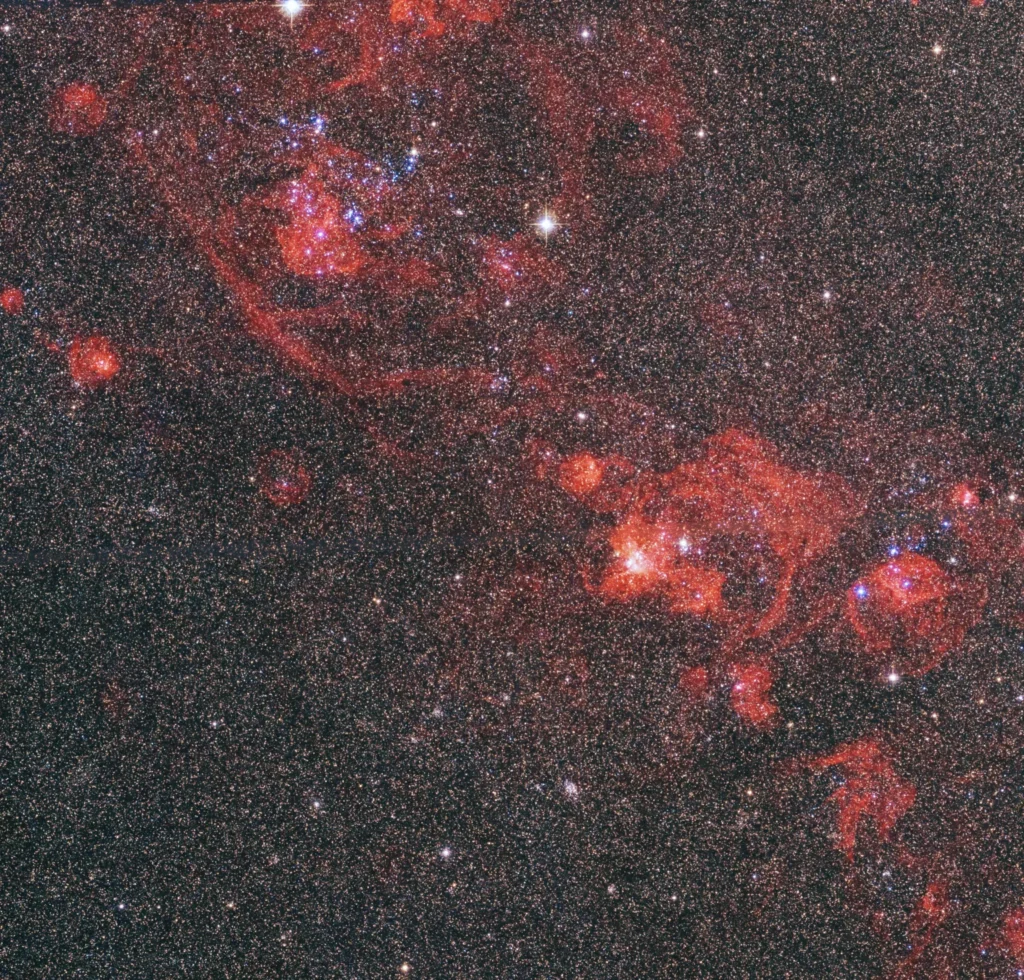The Andromeda Galaxy, or M31, is one of the most captivating celestial objects in our night sky. Located approximately 2.5 million light-years away, it is the closest major galaxy to the Milky Way and is on a collision course with our galaxy in about 4 billion years. Let’s explore what these observations mean, how they were made, and why they are crucial for astronomers studying galaxies near and far.
The Significance of Andromeda’s Spiral Arms and Rosy Tendrils
The spiral arms of the Andromeda Galaxy are more than just beautiful structures—they are cosmic laboratories where stars are born and evolve. These arms contain vast regions of ionized gas, which glow with a rosy hue when illuminated by young, hot stars. These “rosy tendrils” are indicators of active star formation, similar to what we see in the Milky Way’s spiral arms. According to NASA, these areas are filled with ionized hydrogen gas excited by the intense radiation from newborn stars and supernovae. Such regions are often called “stellar nurseries” because they are where new stars are “born” from collapsing clouds of gas and dust.
These observations are significant because they provide a closer look at the processes that drive star formation in a spiral galaxy. By studying Andromeda’s spiral arms, scientists can better understand the similarities and differences between our galaxy and its closest neighbor. This comparison can shed light on how spiral galaxies form and evolve, especially since Andromeda is predicted to merge with the Milky Way in a few billion years. The new findings will help astronomers model what might happen during this galactic collision and how it will affect star formation in both galaxies.
How Hubble Made These Observations
Capturing these detailed images of Andromeda’s rosy tendrils required the power of Hubble’s Advanced Camera for Surveys (ACS) and Wide Field Camera 3 (WFC3). These instruments allow Hubble to peer through layers of gas and dust, providing high-resolution images across multiple wavelengths—ultraviolet, visible, and near-infrared. The combination of these capabilities enables astronomers to analyze different types of stars and gas clouds in various stages of evolution.

NASA, ESA, M. Boyer (Space Telescope Science Institute), and J. Dalcanton (University of Washington); Image Processing: Gladys Kober (NASA/Catholic University of America)
The Hubble images were taken as part of the Panchromatic Hubble Andromeda Treasury (PHAT) program, one of the most detailed surveys ever conducted on a neighboring galaxy. This program mapped a 48,000-light-year-long stretch of Andromeda’s disk in exquisite detail, revealing star clusters, dust lanes, and regions of intense star formation. The data collected not only helps in understanding Andromeda but also serves as a reference for studying other spiral galaxies in the universe. As NASA describes, it’s like “photographing a beach and resolving individual grains of sand,” emphasizing the unprecedented level of detail achieved in these observations.
What These Observations Reveal About Star Formation and Evolution
These observations of Andromeda’s spiral arms offer vital clues about star formation and the lifecycle of stars. The glowing tendrils seen by Hubble are caused by young, hot stars ionizing the surrounding hydrogen gas. This phenomenon is not unique to Andromeda; it happens in many spiral and irregular galaxies where star formation is active. What makes these observations particularly valuable is that they help scientists understand the various stages of star formation—from the initial collapse of gas clouds to the development of young, massive stars that illuminate their surroundings.
By analyzing these star-forming regions, astronomers gain insights into the types of stars being formed, their mass distribution, and their potential to influence the galaxy’s future evolution. The observations also help identify the role of supernovae in triggering further star formation by compressing nearby gas clouds. Understanding these processes is crucial not only for comprehending the dynamics of Andromeda but also for applying these findings to more distant galaxies where direct observation of individual stars is not possible.
The Broader Implications for Cosmology and Future Research
The insights gleaned from Hubble’s close-up of Andromeda extend beyond our local galactic neighborhood. By studying a nearby galaxy in such detail, astronomers can refine models of how galaxies form, evolve, and interact on a larger scale. The PHAT program’s data provides a benchmark for understanding spiral galaxies, which are the most common type in the universe. With Andromeda being our closest spiral galaxy, it serves as a “laboratory” for studying phenomena that are challenging to observe in more distant galaxies.
Moreover, these observations are particularly relevant for preparing for the future collision between Andromeda and the Milky Way. This cosmic event will likely reshape both galaxies, triggering new waves of star formation and possibly altering the structure of the resulting galaxy. Understanding the current state of Andromeda’s star-forming regions allows scientists to predict how these areas might evolve during and after the collision. As NASA’s findings suggest, while stars within each galaxy will likely not collide directly due to vast distances between them, the gravitational interactions will stir up gas and dust, potentially igniting new star formation on a massive scale.
As we look to the future, next-generation telescopes like the James Webb Space Telescope (JWST) will build upon Hubble’s legacy, providing even more detailed views of galaxies near and far. With these powerful tools, astronomers hope to continue piecing together the cosmic puzzle of how galaxies form, evolve, and sometimes collide, creating new opportunities for discovery in the vast universe.
Reference:
Dalcanton, J. J., Williams, B. F., Johnson, L. C., et al. (2015). The Panchromatic Hubble Andromeda Treasury (PHAT): Multi-Wavelength Analysis of M31. The Astrophysical Journal, 810(1), 30. DOI: https://ui.adsabs.harvard.edu/abs/2012ApJS..200…18D/abstract



















